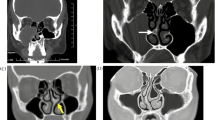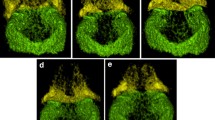Summary
The cricoarytenoid relationship presented with spiral computed tomography was demonstrated and the reconstruction of arytenoid dislocation was presented by using multiplanar reconstruction algorithms. Fifteen patients with arytenoid dislocation documented by fiberoptic laryngoscopy and strobovideolaryngoscopy and 10 normal persons were displayed by spiral computed tomography (CT). A making design of our own had been used to diagnose arytenoid dislocation on axial CT image. Results showed that dislocation of cricoarytenoid joint was consistently demonstrated on several of the overlapping thin axial reconstructions in each of the 15 patients, in whom asymmetry of the bilateral cricoarytenoid joints was noted on axial images. It was found that on the glottic-fissure level the basal angle on abnormal side was larger in 8 patients than that on the normal side and smaller in 7 patients in patient group, whereas right basal angle was equal to the left in 8 subjects, except 2 in control group. There was statistically significant difference in the number of the equal to two basal angles of glottic fissure between control group and patient group (P<0.025). High-quality sagittal and coronal reconstructive images often were helpful in confirming or clarifying the complex arytenoid orientations. The findings that two-side basal angle was not equal in triangle of glottic fissure can be used as an objective parameter to diagnose arytenoid dislocation. Spiral CT is a useful adjunct in the diagnosis and treatment of dislocation of cricoarytenoid joint.
Similar content being viewed by others
References
Sellars I, Sellars S. Cricoarytenoid joint structure and function. J Laryngol Otol, 1983, 97: 1027
Hoffman H T, Brunberg J A, Winter Pet al. Arytenoid subluxation: diagnosis and treatment. Ann Otol Laryngol, 1991, 100: 1
Brosch S, Johansen H S. Clinical course of acute laryngeal trauma and associated effects on phonation. J Laryngol Otol, 1999, 113(1): 58
Talmi Y P, Wolf M, Bar-Ziv Jet al. Postintubation arytenoid subluxation. Ann Otol Rhinol Laryngol, 1996, 105: 384
Alexander A E, Lyons G D, Fazekas-May M Aet al. Utility of helical computed tomography in the study of arytenoid dislocation and arytenoid subluxation. Ann Otol Rhinol Laryngol, 1997, 106(12): 1020
Agha F P. Recurrent laryngeal nerve paralysis: a laryngographic and computed tomographic study. Radiology, 1983, 148: 149
Robert Y, Rocourt N, Chevalier Aet al. Helical CT of the larynx: A comparative study with conventional CT scan. Clinical Radiol, 1996, 51(12): 882
Sataloff R T, Bough I D, Spiegel J R. Arytenoid dislocation: diagnosis and treatment. Laryngoscope, 1994, 104(11): 1353
Author information
Authors and Affiliations
Additional information
Wang Zhibin, male, born in 1957, Associate Professor
Rights and permissions
About this article
Cite this article
Zhibin, W., Liming, X. & Chengyuan, W. Utility of spiral computed tomography in the study of dislocation of cricoarytenoid joint. Current Medical Science 23, 78–80 (2003). https://doi.org/10.1007/BF02829471
Received:
Published:
Issue Date:
DOI: https://doi.org/10.1007/BF02829471




